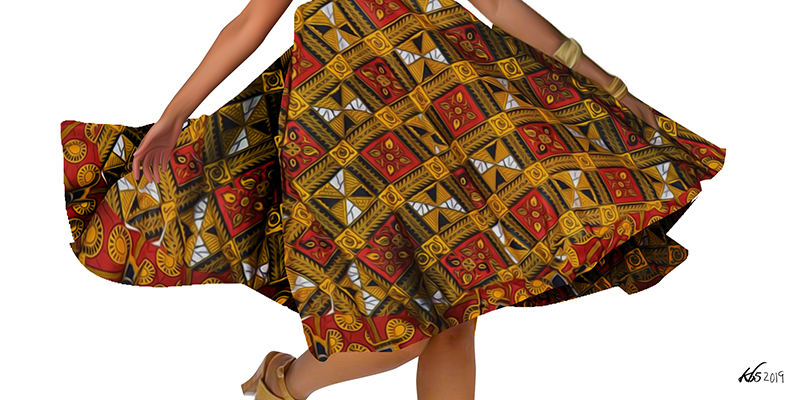An Interview with Joy Mboya
Joy Mboya is the Director of the GoDown Arts Centre in Nairobi—a nonprofit institution for the convergence of the arts in Nairobi and East Africa. Between 2003 and 2005, the GoDown Arts Centre hosted the Sunlight Quest for Kenya’s National Dress; an interactive process that was designed to generate concepts for Kenya’s national attire. This project definitely advanced conversation but was not publicly adopted by a critical mass, with many Kenyans saying that the outfits were not practical or suitable for daily use. There has been little reflection on the objectives and scope of the project, the extent of its public engagement strategies, and its successes and failures. Joy spoke with us about her experiences with the project and her thoughts on Kenyan national identity.
***
Back when I was in my 20s, there were very few spaces that had been fleshed out to support the newly minted fashion designer. So for the longest time, if you wanted to get anywhere, the Smirnoff Fashion Awards were huge. At this level it was quite your run-of-the-mill show; maybe somebody bought a piece or two but not too much else happened there. However, it was still exciting, and in the event that you won the local award, you qualified to compete for the global award at a ceremony attended by huge international designers and fashion houses, and maybe somebody important would notice you and something might happen.
Now, more and more, I think corporates do better in the arts when they form foundations that have a separate plan for their engagements from their general business agenda. This way, their support can be more deliberate and long-term, aside from having one moment in the light. But the Smirnoff Fashion Awards, other early fashion shows, and all the beauty pageants were real opportunities back then. Corporates were growing and solidifying their brands by linking up with fashion, glamour, contemporary style, you name it.
Patricia Ithau was a former Miss Kenya and had been a model for a long time, remaining very interested in fashion even after she left the scene.
So it was no surprise that when she had the opportunity to spearhead the idea of a national dress, she really ran with it. It would not have happened without her interest and her push at Unilever, without her saying “Here’s an opportunity, Sunlight,( a Unilever detergent brand) let’s do something”. She had a big connection with fashion designers because of her history in the industry, so she begun to seek out people she knew to see how they could be involved. She is the one who brought in the government through the Ministry of Culture, to ensure it was something the state bought into, to make everything national and formal.
The GoDown was still fairly new then—that was around 2003—and we said we would be happy to host the tangible parts of the process and coordinate whatever meetings they needed. Unilever would put out the call and then we would receive the submissions, exhibit them publicly, assist them in identifying teams of cultural experts for follow-up, that kind of stuff.
Ideating a National Dress
Early on in the process, our priority was moderating the designers to make sure they kept an open mind, that they did not get bogged down with individual perspectives but remained aware of the wider space. The first thing they did was gather all the ideas that had been submitted, pin them on the walls and stand back and ask themselves, “What’s happening here?” I think they recognized early—and this was of course rather difficult to relay—that the notion of a national dress, especially in Kenya, was going to be influenced by too many different things, and that they were never going to actually create a national dress, by themselves, from scratch. What the designers could truly offer was an informed way to see how we as Kenyans clothed ourselves, how we worked with the body and what parts of the body we emphasized, combined with what was happening in the contemporary space, and what elements of all this were worth carrying forward.
It was tough. The designers would make presentations during the earlier focus group meetings, and many people would come in actually expecting a final dress. But the designers would still be talking about concepts that were showing up in a lot of traditional dress: the cape representing a moment of ceremony or status for men; some kind of adornment across the chest; the loincloth with optional cover of the behind for women (this was where the notion of the apron came from); headdresses to make the face an obvious focal point and such. Everybody was hanging something around their ears, piercing their lips, or even wearing mud caps that they could stick feathers into, to give some examples.
The designers were wondering how to begin working with all these interesting sensibilities to create a final product. Just before they began, they wanted the public to participate in the process, so that there could be buy-in from the very beginning. Having them choose a dress at that stage was going to be impossible, so they thought through what would be a more realistic set of options. They decided that perhaps the public could choose the colours they would most prefer on a Kenyan national dress. Sunlight tied it in with a marketing gimmick about washing clothes that wouldn’t fade, which I think was a bit myopic. Marketing is fine, but not if it is going to interrupt an intricate, important process.
The ideas that the designers actually put forward were just concepts. They never, ever, described them as dresses. They wanted to put these out so that Kenyan fashion designers would begin to design original pieces interpreting them, which they would then sell to the people, also hoping that some members of the public would be a bit adventurous and absolutely do their own thing. Building familiarity with and acceptance of these would need a huge marketing push, obviously. Fifty million shillings had already been spent mobilizing ideas from the nation, taking the designers to visit different places to learn about different cultures, putting together focus groups, having presentations, and all.
So How Did You Sustain That Kind of Momentum and Energy?
This was where Patricia was really clever and strategic—she knew that once the brand was done making their statement, they weren’t going to throw any more millions into the project. That was her main reason for bringing in the Kenya Government, through the Ministry, because hopefully they would become excited enough to kind of keep this thing going.
That was the grand hope, that these things would find their own legs. Some of the designers who were not part of the original process began to pick it up. Wambui of Moo Cow* (*Wambui Njogu, one of the two founders of the Kenyan fashion label Moo Cow, which was established in 2002.) did some funky leather aprons that could be worn over denim jeans. People got excited about making their own extended aprons from the neck all the way down. Even the government picked up some elements of it. One of our sports teams actually made some of the concepts into the team costume, of course in the Kenya colours. The ladies had a red skirt, with black trim, embroidered on, which suggested the apron—I don’t think there was a separate flap. The men in that particular group had the three-notch treatment at their necklines.
Ideally, we would be seeing pieces evolved from the national dress concepts all the time, not just for special occasions or trips abroad, until it was no longer new or weird and it became part of how we saw ourselves. We would be feeling like we needed these pieces for our full identity, and starting to buy them. We didn’t have that opportunity to make a lasting presence, however. One thing that ended up happening was that designers made items that the public considered overpriced and were labelled as luxury items when the designers didn’t intend them to be seen that way. They were just trying to make back their money and make a decent profit. Nobody quite picked up the cape. I wonder whether it was too expensive or if they just were wondering, “How am I going to pull this off?” But we almost introduced it again when Willy Mutunga was Chief Justice. We said we would be happy to pull together a team of designers to really think about the Supreme Court judges’ dress. He was excited about that*.
*Kenyan judges eventually opted to retain their existing robes, but made the donning of the whitish-grey horsehair wigs optional. Mutunga, Hon. Justice Dr Willy, S.C., Dressing and Addressing the Kenyan Judiciary, 2011, Kenya Law Journal, Nairobi, Kenya
One of the designers said, “Hang on, what if we revive the cape from the national dress? We could rethink it for the Chief Justice, maybe for the big ceremonies so he doesn’t have to wear it all the time?”
That idea was taken to the judges and some of them thought it was a bit too much. I remember meeting one of them in the corridor and he asked, “Joy, what are you guys about to dress us in? Taking us back to hides and skins?*”
*Kenyan Judges Change Titles, Dress Code, 2011, The Daily Monitor, Kampala, Uganda
People always come back to me and to the Godown, trying to find out what happened to the national dress, and why it just vanished into the ether. University students especially have come by to investigate this as part of their Master’s Degree, so all their theses must be sitting around somewhere*.
Misati, Beatrice N., Kenya National Attire: Factors Influencing adoption, 2008, School of Arts and Design, University of Nairobi, Nairobi, Kenya
Imo, Beatrice Elung’ata, Adoption of the Kenya National Dress as a Basis for Developing a Decision-Making Model for the Local Industry, 2013, Department of Fashion Design and Marketing, Kenyatta University, Nairobi, Kenya
Many of them were a lot more interested in the process of the design. But most feedback from the general public was asking the question, “Why did you think that you could prescribe a dress for us that was not the dress we wanted?”
We’d all conveniently forgotten the extensive public participation and iteration. But I also think that some things just take time, and perhaps people only really get into a thing like this when given a certain amount of time. Perhaps the national dress needed that kind of continuous engagement so that ten years on we would consider saying, “Actually, what happened to the apron? What happened to the shirt?” People needed to interpret their own nationhood through growing familiarity with the national dress concepts. They needed to be reassured that these concepts had actually come from long deliberations over our diverse origins and cultural heritage, and that the concepts were open for all kinds of interesting interpretations as time passed, not just what the designers had put together back then.
We needed exhibitions and discussions over a much longer period than we imagined, to get a project of this weight to stick and gain traction with the people. The Sunlight process with the public and the designers provided the opportunity to say, “If you create something that doesn’t reference heritage or doesn’t pay attention to culture, Kenyans will reject it.”
Coming To Terms with the Rejection
But diverse cultural references were there, and yet there was still rejection.
So was it that it was not pretty enough, and if so, what could people have wanted ‘pretty’ to be? I don’t know. The most interesting question now, for me, is how to get to the root of what Kenyans are actually complaining about, because it wasn’t clear then and in many ways it still isn’t. None of the shirts ever took off in any way so the men did not really have anything, but there had been a few ideas here and there that the women had found interesting. There was even a concept of the dress for women who wore hijab. I think there was also a real missed opportunity in the Minister for Culture—that was Balala*, then.
* Hon. Najib Balala, who served as Minister for Gender, Sports, Culture and Social Services between 2003 and 2004.
He would seize on anything that would amplify his ministry and his role. He could have said, “For as long as I’m the Minister for Culture let me just keep this thing alive.” I think that perhaps the urgency was just not seen at that time. Perhaps the designers didn’t succeed in communicating that the concepts they saw were prototypical aesthetics, if they can be called that. That the way that women in one community would cover themselves across the front was by using a loin cloth, certainly, but that loin cloth was not exactly the same from one community to another. Everybody did it in whichever material was locally available, for their local climate and regional sensibilities. So, again, there was never going to be a national dress in that immediately formulaic sense of, “Ah, that’s a Kenyan dress. Are you Kenyan?” “ Yes.” “ I see you’ve got an apron, and the other Kenyan’s got a different apron.”
How Do We Just Accept That We’re so Incredibly Diverse and Different?
It was not going to be like that for a long time, at least, not without continuity, public education and sustained visibility. It was always going to be a difficult project. It would have been progressive to keep it alive for a decade or two and see what would we would have had in the end. I think Kenyans are beginning to accept is that one of the things that stands out about us is our diversity. We haven’t reduced that diversity yet into a single thing or a few core things in the same way that the West Africans seem to have done. I do not know how they did it. Perhaps their kingdoms and organizational structures were much more visible, and therefore notions of kings, chiefs and ceremonial dress were much more immediate in their minds than in ours? I have no idea. But more and more now I wonder, “How do we first of all just accept that we’re so incredibly diverse and different?”
How can we become excited about that, and then allow it to organically find the things that will coalesce into the cores, into the singles? Everything else that remains can just be allowed to stay different, you know? Maybe trying to look at these things in only one way is a reason we will continue going astray, or asking ourselves questions that have no answers.
In terms of diversity, one of the people who has a wonderful story around that is Tabu Osusa of Ketebul*, who says that when Kenya did a showcase at the 2014 Folklife Festival at the Smithsonian Institution, our musical presentation was called exceptional because it was so diverse.
*Ketebul Music, a Kenyan record label and studio founded in 2007.
People already knew the South African sound, or the West African kora which was lovely and beautiful but nothing was really changing. It was just the same kinds of sounds all the way through. But when they saw the Kenyan spread, they began to pay attention because it couldn’t be defined by one thing or a few things. So my thought now is to interrogate that and figure it out, instead of panicking and seeing it as a problem.
It is not clear whether the failure of this project to gain traction with the Kenyan public was due to the communication and marketing, the underestimation of the work and time needed by the parties involved, or a combination of these and other factors. Several things have happened in the thirteen years since this process, with regard to urban national conversations on identity and fashion.
The Africa Rising narrative, with increased optimism about Africa’s future and greater continental esteem, has led to the opening up of cultural borders to new generations of young Kenyans. This has had a wider audience because of access to tech, information and social media, with more of them finding ways to integrate cultural pieces not just into ceremonial or occasion clothing, but also into practical, everyday garb. The 2009 publication of a national culture and heritage policy* openly declared state interest in development of national attire. (National Policy on Culture and Heritage, 2009.)
There is also a greater desire for and consumption of clothing designed by Kenyans and inspired by Kenyan cultures. It is possible that this set of brewing cultural conditions could better demonstrate the importance of a national dress, beyond an abstract need to stand out from other Africans in international fora. Perhaps wider cultural dialogue must occur before a national dress can truly evolve from our shared, diverse ethnic experiences in a way that will be more widely acceptable to citizens. It is also possible that national dresses evolve organically from cultures only when they are ready to do so, and that it is not a shortcoming to lack one.
Endnote
The 2004 Sunlight Quest for a National Dress remains a critical attempt to create recognizable national symbols through attire, beyond the flag, the national anthem, the coat of arms and the public seal*.
(Article 9: National Symbols and National Days, from Chapter 2 – The Republic, The Constitution of Kenya, 2010, Kenya.)
This interview was originally published in the fashion book Not African Enough ( 2017) by the Nest Collective and republished with their permission.







